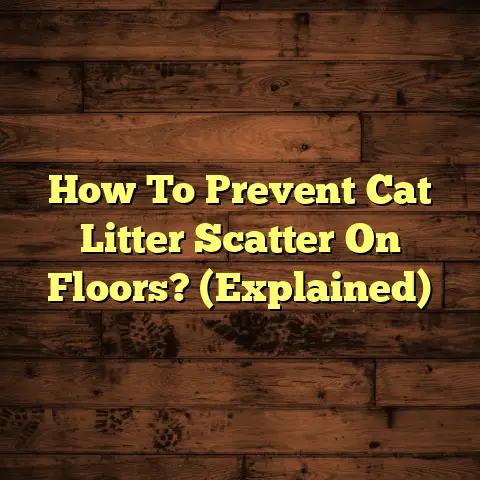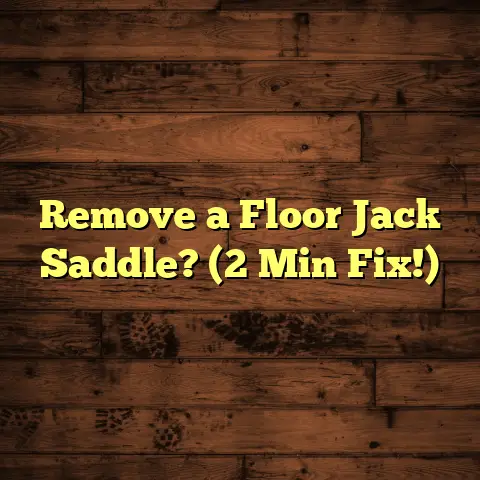Bugs Eating Wood Floors? (5 Prevention Secrets!)
“I never thought I’d have to worry about bugs eating my beautiful hardwood floors.
After finding tiny holes and wood dust, I realized I had a serious problem on my hands!” – Sarah T., Homeowner
As a flooring contractor, I’ve seen firsthand the devastation that wood-eating bugs can cause.
It’s a homeowner’s nightmare, turning beautiful floors into a buffet.
But don’t panic!
With the right knowledge and proactive steps, you can protect your investment.
Section 1: Understanding the Culprits
Let’s talk about the usual suspects.
We’re not dealing with your average housefly here.
We’re talking about wood-devouring insects that can compromise the structural integrity of your floors.
- Termites: These are the big bad wolves of wood destruction.
They live in colonies and can cause extensive damage before you even notice they’re there. - Carpenter Ants: They don’t actually eat wood, but they excavate it to build their nests, leaving behind galleries and sawdust-like frass.
- Wood-Boring Beetles: This is a broad category, including powderpost beetles, deathwatch beetles, and others.
Their larvae bore into wood, creating tiny holes and weakening the structure. - Powderpost Beetles: These guys are sneaky!
They leave behind a fine, powdery dust (hence the name) as their larvae munch away inside the wood.
Each of these pests leaves distinct signs.
Termites often create mud tubes, while carpenter ants leave coarse sawdust.
Beetles leave small, round exit holes.
According to the National Pest Management Association (NPMA), termites alone cause over $5 billion in property damage each year in the US.
That’s a staggering number!
And wood-boring beetles?
They’re a common problem, especially in older homes with untreated wood.
Section 2: The Life Cycle of Wood-Eating Bugs
Understanding how these pests live and breed is key to stopping them.
Think of it as knowing your enemy!
Let’s break it down:
- Egg: It all starts with an egg, laid in cracks, crevices, or existing tunnels in the wood.
- Larva: The egg hatches into a larva, which is the real eating machine.
Larvae bore into the wood, feeding and growing. - Pupa: The larva transforms into a pupa, a transitional stage where it develops into an adult.
- Adult: The adult emerges from the wood, ready to mate and lay more eggs, continuing the cycle.
The duration of each stage varies depending on the species and environmental conditions.
For example, some wood-boring beetle larvae can live inside wood for several years!
Knowing this life cycle helps us target our prevention efforts.
For instance, treating wood with a borate solution can kill larvae before they mature.
Section 3: Prevention Secret #1: Regular Inspections
Think of regular inspections as your first line of defense.
It’s like checking your car’s oil – a little preventative maintenance can save you from major headaches down the road.
Here’s a checklist for your inspections:
- Frequency: At least twice a year, ideally in the spring and fall.
- Tools: A flashlight, a screwdriver (to probe suspicious areas), and a keen eye.
- What to look for:
- Small holes in the wood
- Sawdust-like frass or powder
- Mud tubes (especially near the foundation)
- Soft or spongy wood
- Visible insects
Don’t forget to check those hard-to-reach areas!
Underneath cabinets, in crawl spaces, and along baseboards are prime hiding spots.
Hiring a professional pest inspector is also a great idea.
They have specialized tools and training to detect infestations that you might miss.
Section 4: Prevention Secret #2: Proper Wood Treatment
Treating your wood is like giving it a shield against these invaders.
Think of it as applying sunscreen before heading to the beach!
There are two main types of treatments:
- Chemical Treatments: These include borate-based solutions, insecticides, and fumigants.
Borates are particularly effective because they penetrate the wood and kill larvae. - Natural Treatments: These include essential oils like neem oil and orange oil, which can deter pests.
These are often less toxic but may require more frequent application.
I always recommend treating wood before installation, especially if you’re using reclaimed lumber.
You can also apply treatments during maintenance, such as when refinishing your floors.
For example, you can use a borate solution like Tim-bor Professional.
It’s a powder that you mix with water and apply to the wood.
It penetrates the wood and kills any existing larvae.
Section 5: Prevention Secret #3: Controlling Moisture Levels
Moisture is like a beacon for wood-eating bugs.
They love damp, humid environments.
Think of it as setting up a five-star resort for pests in your home!
Here’s how to keep moisture in check:
- Dehumidifiers: Use them in basements, crawl spaces, and other damp areas.
- Ventilation: Ensure proper ventilation in bathrooms and kitchens.
- Fix Leaks: Address any leaks in your roof, plumbing, or foundation immediately.
- Gutters: Keep your gutters clean and functioning properly to direct water away from your foundation.
The ideal moisture level for wood floors is between 6% and 9%.
You can measure this with a wood moisture meter, which you can find at most hardware stores.
Section 6: Prevention Secret #4: Sealing and Repairing Gaps
Gaps and cracks in your wood floors are like open doors for pests.
They provide easy access to the wood and create a cozy environment for them to nest.
Here’s how to seal those gaps:
- Caulk: Use caulk to seal gaps along baseboards and around pipes.
- Wood Filler: Use wood filler to repair cracks and holes in the floorboards.
- Sealant: Apply a sealant to the entire floor to create a protective barrier.
When choosing materials, look for products that are specifically designed for wood floors.
For example, a flexible sealant will move with the wood as it expands and contracts with changes in humidity.
Repairing existing damage is also crucial.
Rotting wood is especially attractive to pests, so replace any damaged boards as soon as possible.
Section 7: Prevention Secret #5: Landscape Management
Your landscaping can have a big impact on whether or not pests invade your home.
Think of it as creating a buffer zone around your property.
Here are some tips for managing your landscape:
- Wood Piles: Keep wood piles away from your foundation.
Store them off the ground and cover them with a tarp. - Trees and Shrubs: Trim trees and shrubs so they don’t touch your house.
This prevents pests from using them as bridges to get inside. - Drainage: Ensure proper drainage around your foundation.
Water should flow away from your house, not towards it. - Mulch: Use mulch wisely.
While it can be beneficial for your plants, it can also attract pests.
Keep it away from your foundation and use a thin layer.
For example, instead of using wood mulch, consider using gravel or stone.
These materials don’t retain moisture and are less attractive to pests.
Conclusion
Protecting your wood floors from bugs is an ongoing process.
It requires vigilance, proactive measures, and a little bit of elbow grease.
But the rewards are well worth the effort: beautiful, durable floors that will last for years to come.
Remember these five prevention secrets:
- Regular Inspections
- Proper Wood Treatment
- Controlling Moisture Levels
- Sealing and Repairing Gaps
- Landscape Management
Call to Action
Don’t wait until you see signs of infestation to take action.
Start implementing these prevention secrets today!
Your floors (and your wallet) will thank you.
Have you had experience with wood-eating bugs?
Share your stories in the comments below!
And if you suspect an infestation, don’t hesitate to call a professional.
It’s better to be safe than sorry!





